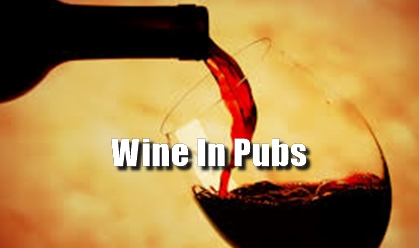In vino veritas (In wine is truth) – Proverb quoted by PLATO, Symposium 217 (also attributed to Pliny the Elder)
Creating a wine list
Whether you serve food or not and whether your wine list runs to half a dozen or twenty wines it is important you create a professional wine list for your pub.
A YouGov poll for the Wine & Spirit Trade Association in September 2016, showed 30% of adults said they drank white wine at home in the previous month, joint top with lager and one point ahead of red wine.
White wine and red wine came top when people were asked what they drank in a restaurant too, but when the question switched to pubs, wine slipped in popularity. Only 12% said they had drunk white wine in a pub in the previous month, behind lager, ale, cider and vodka. Red wine was also below gin at 8%.
You might want to incorporate your wine list into your food menu (although your wine list might change more often than your food menu so this may not be the best unless you are prepared to constantly revise and reprint your food menu). You might want to produce a separate wine list (in most pubs I have run I have produced a separate list) in which case it serves the same function as a food menu and needs as much care and attention.
Whichever route you choose your list should be up to date (in terms of stocking list and price) and should give correct details of the wine’s origin, strength and vintage.
You can choose to offer a wine list ordered by price, or by country of origin or by type of grape used in production, it all depends on the length of your wine list.
Some description of the wine (like a beer tasting note) is often useful as is an indication of how dry or sweet a wine is. If you do add tasting notes keep them short and simple, most wine bottles now come with this information.
Your list should be balanced for red, white, rose and sparkling wines and if you stock it champagne. Try and include New World wines (Australia, New Zealand, Chile, California) and Old World wines (France, Germany, Italy, Spain). You might want to include one of the many fine English wines now available, especially if it is produced locally.
See if your supplier is stocking any of these suggestions…
15 Best English Sparkling Wines For Summer 2018
The Search for integrity and provenance – “hipster wine”
Gary Keller, senior wine buyer at Molson Coors , says Italy is one of the strongest performing regions for the company, with growth also coming from Argentina and Chile.
Simon Thorpe MW, managing director at specialist Australian wine supplier Negociants UK, says there’s a desire among consumers to see wines on pub menus that go beyond wholesalers’ house wines or big brands. “There is definitely a sense of searching for product integrity in the marketplace, moving towards those wines that have a sense of place or personality, and we have seen a real interest in Australian wine in smaller producers making, for want of a better word, craft wine in smaller volumes.”
Grape Varieties
Whilst there are literally hundreds of grape varieties to choose from there is a limited number that you (or your customers) are likely to encounter.
Red Grapes
CabSav – you’ll find it everywhere – the ubiquitous Cabernet Sauvignon is one of Bordeaux ‘s most famous varieties and has been exported to vineyards the world across.
Another Bordeaux favourite is Merlot and hugely popular this is a sure winner on any wine list, whether it’s old or new world.
Gamay is the grape famously used in Beaujolais Nouveau wine, from France. It is often drunk young as in these light fruity reds.
Shiraz (sometimes known as Syrah) comes from the Rhone region of France but is also Australia’s most planted grape. Producers the world over especially in California, love it as it is so versatile with all sorts of food.
Pinot Noir from Burgundy is another hugely versatile wine and whilst it is predominantly an old world wine many new world vineyards are producing interesting wines based on this grape.
Zinfandell is, perhaps, the world’s most versatile wine grape, making everything from blush wine (White Zinfandel), to rich, heavy reds.
Sangiovese produces the Chiantis of Italy’s Tuscany region and, of late, good wines from California.
White Grapes
Chardonnay is by far the most popular white grape and is used not only for the medium dry wines labelled as Chardonnay (with all its fruity and citrus flavours) but also used in production of the dry Chablis variety. It’s so popular because it will grow anywhere from South America to Australasia and even in the British Isles.
Chenin Blanc is another versatile white grape and you’ll find it in sweet and dry wines from France to South Africa and especially in California.
Another (and sometimes much maligned grape) is Riesling, associated primarily with Germany it is also grown in France. It makes some really good dry wines and also some of the better sweet wines around.
Sauvignon Blanc grown throughout the great French regions (Sancerre, Pouilly Fume and Gironde) it also crops well in New Zealand and South Africa. You’ll find it used in the sweet wines of the Sauternes and is often blended with Semillon.
Semillon which is traditionally associated with the Burgundy region of France is also popular in Australia and Chile. Whilst it stands well on its own it is often blended with Chardonnay and Sauvignon Blanc.
Continue reading … page 2
